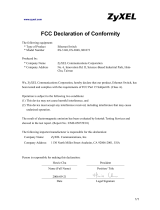
Table of Contents
NAP Series User’s Guide
4
Table of Contents
Contents Overview .............................................................................................................................3
Table of Contents.................................................................................................................................4
Chapter 1
Introduction ..........................................................................................................................................6
1.1 Overview .......................................................................................................................................... 6
1.1.1 Dual-Radio ............................................................................................................................... 6
1.2 Ways to Manage the NAP ............................................................................................................... 7
1.3 Good Habits for Managing the NAP .............................................................................................. 7
1.4 Hardware Connections ................................................................................................................... 8
1.5 LEDs .................................................................................................................................................... 8
1.5.1 NAP303 ..................................................................................................................................... 8
1.5.2 NAP203 ................................................................................................................................... 10
1.5.3 NAP102 ................................................................................................................................... 11
Chapter 2
The Web Configurator........................................................................................................................14
2.1 Overview ......................................................................................................................................... 14
2.2 Access .............................................................................................................................................. 14
2.3 Navigating the Web Configurator ............................................................................................... 15
2.3.1 Title Bar ................................................................................................................................... 15
2.3.2 Navigation Panel .................................................................................................................. 16
2.3.3 Warning Messages ................................................................................................................ 17
Chapter 3
Dashboard..........................................................................................................................................18
3.1 Overview ......................................................................................................................................... 18
3.1.1 What You Can Do in this Chapter ....................................................................................... 18
3.2 Dashboard ...................................................................................................................................... 18
Chapter 4
Network...............................................................................................................................................20
4.1 Overview ......................................................................................................................................... 20
4.1.1 What You Can Do in this Chapter ....................................................................................... 20
4.2 IP Setting ......................................................................................................................................... 20
4.3 VLAN ................................................................................................................................................ 21
Chapter 5
Troubleshooting..................................................................................................................................24





















